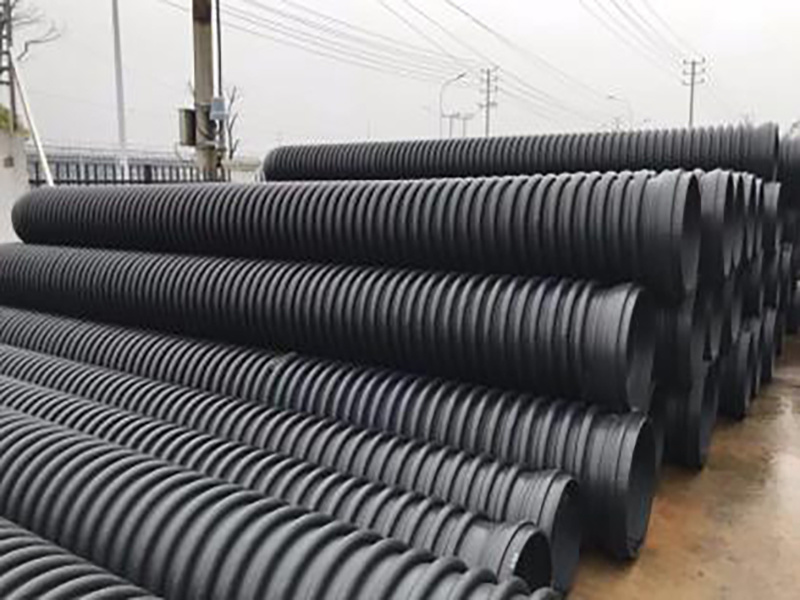Kela Pipe: Innovation and Application of High-Performance Pipe Materials
2025-06-13

I. Core Technology and Process of KRALA Pipes
KRALA pipes are produced using a hot-state winding molding process. The core of this process involves uniformly winding molten HDPE flat strips and U-shaped strips onto a heated roller mold at predetermined positions. This process ensures the quality of the welds, especially the welds of the flat strips, which are covered by the polyethylene-sheathed support pipe, significantly improving the pipe's external pressure resistance. In addition, the production process of KRALA pipes strictly follows the national standard GB/T 19472.2-2017 Type B structural wall pipe standard and the European standard EN-13476 to ensure the stability of product quality.
KRALA pipe product series are divided into four types: PR, OP, SQ, and VW:
PR, OP series: Mainly used for underground drainage pipes, with a smooth inner wall and an irregular reinforced outer wall structure. The standard length of the pipe is 6 meters, and the inner diameter range is DN300-DN4000.
SQ series: Used for manufacturing containers or manholes, suitable for scenarios requiring high-strength structures.
VW series: Mainly used for secondary processing and molding of pipe fittings such as three-way valves and elbows, meeting the needs of complex pipe network systems.
II. Performance Advantages of KRALA Pipes
1. High Strength and Flexibility
KRALA pipes exhibit good flexibility on a macroscopic scale, capable of adapting to geological activities such as earthquakes and uneven ground settlement, reducing the risk of pipe damage. At the same time, its local pipe sections have high rigidity and external pressure resistance, suitable for laying under heavy-load pavements.
2. Corrosion Resistance and Long Lifespan
HDPE material has excellent chemical corrosion resistance and can be used for a long time in corrosive soil or fluid environments without anti-corrosion treatment. The design lifespan of KRALA pipes can reach more than 50 years, and they are maintenance-free during their lifespan, significantly reducing the life-cycle cost.
3. Efficient Installation and Environmental Protection
KRALA pipes use butt fusion connection technology, and the connection achieves molecular-level fusion, ensuring 100% leak-proofness. Its weight is only 1/3 of traditional pipe materials, making it easy to transport and construct, simplifying construction procedures and shortening construction time. In addition, KRALA pipes can be 100% recycled and reused, in line with green and environmental protection concepts.
4. Low Roughness and High Flow Rate
The inner wall roughness N of KRALA pipes is approximately 0.010. When transporting fluids, the frictional resistance is small, and the water transmission capacity can be increased by more than 30% compared to cement pipes. This characteristic allows it to replace traditional pipe materials with smaller inner diameter pipes under the same conditions, reducing engineering costs.
III. Application Fields of KRALA Pipes
1. Municipal Water Supply and Drainage Systems
KRALA pipes are widely used in urban underground drainage, sewage, rainwater collection, and water transmission projects. Their corrosion resistance and high strength make them an ideal choice to replace cast iron pipes and cement pipes, especially suitable for areas with narrow construction sites and complex underground pipelines.
2. Water Conservancy Projects
In long-distance water transmission, agricultural irrigation, and reservoir dredging projects, KRALA pipes, with their external pressure resistance and long lifespan, ensure the stable operation of the system.
3. Environmental Protection and Chemical Engineering
KRALA pipes can be used for deep-sea sewage discharge, sewage treatment, and chemical fluid transmission pipelines. Their corrosion resistance is particularly prominent in acidic and alkaline soils.
4. Transportation and Construction Engineering
In railway, highway communication cable protection pipes, and building rainwater pipes and underground drainage pipes, the flexibility and durability of KRALA pipes meet the needs of complex construction environments.
5. Special Environmental Applications
KRALA pipes are suitable for harsh environments such as tidal flats, saline-alkali land, and seabed riverbeds. Their earthquake resistance and disaster reduction capabilities are significantly advantageous in areas with frequent geological activities such as earthquake zones.
IV. Market Prospects of KRALA Pipes
With the acceleration of urbanization and the improvement of environmental protection requirements, the market demand for KRALA pipes continues to grow. Their lightweight, corrosion-resistant, and long-life characteristics make them have broad application prospects in the renovation of old pipe networks, sponge city construction, and rural revitalization projects. In the future, KRALA pipes are expected to replace traditional pipe materials in more fields and become mainstream products in the pipe industry.
V. Conclusion
As a high-performance pipe material, KRALA pipes, with their unique manufacturing process and excellent performance, have demonstrated strong competitiveness in many fields. Their environmentally friendly, durable, and efficient characteristics not only meet the requirements of sustainable development but also provide reliable solutions for engineering construction. With continuous technological advancements, KRALA pipes will play an even more important role in the future pipe industry.
Next page:
Contact us
Email:
xucipeng163@163.com
Mobile:
+86-139-2217-2108
Company address:
Haoliang Industrial Park, Longtang Town, Qingcheng District, Qingyuan City, Guangdong Province

Service hotline:
Service mailbox:

5-year warranty commitment, lifetime technical consultation - Lianhong Pipe Industry, making pipes the most reliable silent partners
HUATAO GROUP
Online message to get application solutions for free
Copyright © 2025 Guangdong Lianhong Pipe Industry Co., Ltd.







